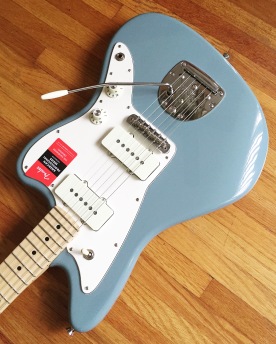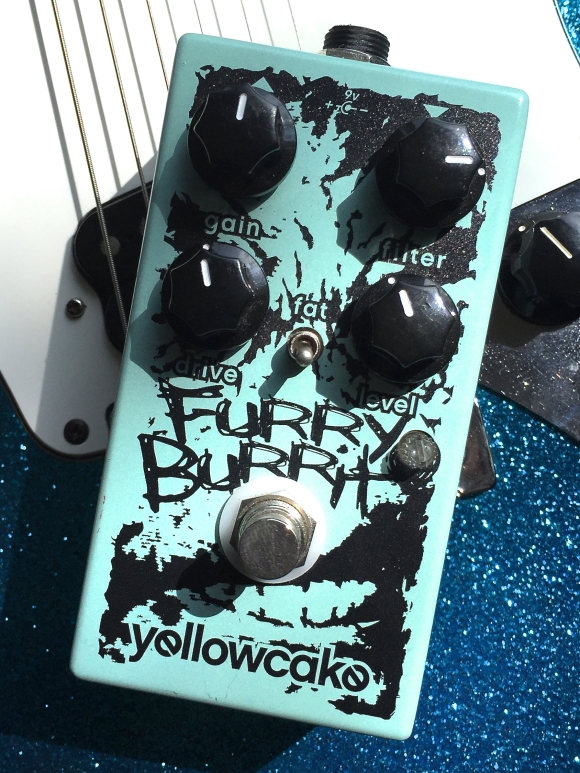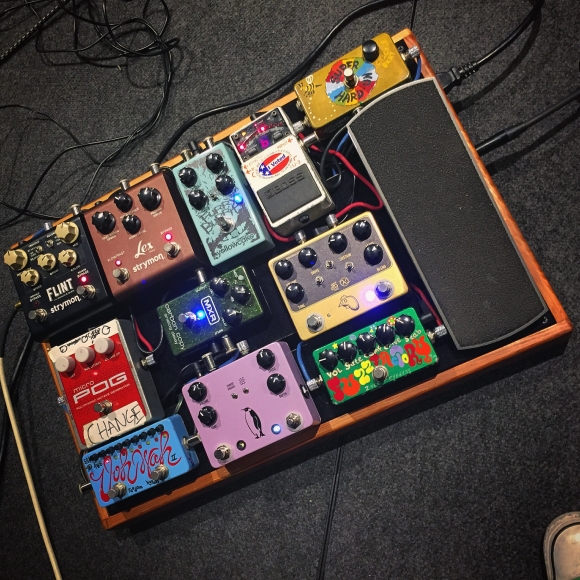Whether it’s fawning over custom colored Jags or addressing some playability problem on a Jazzmaster, it’s safe to say we talk a lot about offset Fender guitars. It’s been an honor to help guitarists understand the quirks associated with them, yet one such quirk we’ve not addressed previously is the tonal range of these guitars.
While it’s true that both the Jaguar and Jazzmaster are capable of some truly bright trebles, they’re also capable of some deep, complex low end. Newcomers to the sound often home in on that brightness and fear that they’ve bought a guitar they can’t use. If that’s you then I’m here to help.
In no particular order, here’s a short list of ideas to help you tame the shrill from your offset Fender guitar. But before we dig in, I’d like to note that guitars being the sum of their parts, the suggestions I’m about to make likely won’t offer a night-and-day change in the sound of your guitar. To put a numerical value to it, you may find that they only amount to a 5% difference, but that could be the 5% you need.
This list may be offset-centric, but these suggestions can apply to just about any guitar.

Examine Your Amp Settings
We guitar players can be rather superstitious. Once we find that sound in our heads, once we settle on those ‘magic’ numbers, it seems like sacrilege to deviate. If this is you, take a deep breath and get centered because the very first suggestion I have for those afflicted by harsh treble frequencies is to simply dial them out.
For symptoms of excessive brightness my prescription is to start with the Presence, assuming your amp has this control. Presence knobs govern the very top of the top end (around 3-7khz-7khz) and as such turning down this knob can have a dramatic effect on undesirable ice-pick frequencies.
Treble controls most often govern the more tuneful highs in of a guitar signal (typically 1.5khz-4khz) so you may find that pruning too much here kills some pleasantness. Still, with the ample treble produced by Jazzmasters and Jaguars, you may find that you won’t need as much to keep things defined.
Now, your instinct may be to roll up the Bass knob and that may certainly help a thinned-out guitar, but be careful not to use this as a catch-all solution. Guitars generally live in the upper EQ bands of a mix, and while punishing low end sounds (and feels) great on its own, you also run the risk of muddying up a full band sound by boosting bass too much. Remember to leave space for other instruments.
You can also try utilizing the tone controls of drive pedals in the same way, cutting highs before you hit the amp. Using a darker pedal or settings before a bright amp can yield some lovely tones, or if you’re the kind that likes bright cleans and dense overdrive, this may be the way to go.

Roll Off that Tone
Knob
I think a lot of folks have been emotionally scarred by the cheap electronics of affordable instruments, but there’s really no reason to fear the humble variable low-pass filter. Sure, a bad tone control can do sickening things to the sound of a beloved instrument; a good one can be an effective secret weapon.
I’ve long maintained that the stock Jazzmaster tone control is one of the most usable ones around. The combination of the 1meg linear potentiometer and a 333 capacitor just seems to dial out the exact high end frequencies that my ears find so unpalatable without sacrificing clarity.
It may help if you think of your tone control as a taste control instead; depending on your musical situation, you can really change the flavor of your guitar’s response to fit the moment. On my personal Jazzmasters, I leave the Tone knob at 6 or 7 as my basic sound and if I need a thicker sound, backing off to 4 or 5 does the trick. If I need twang, rolling up to 10 is almost like picking up a really good Telecaster. I’ve even gone so far as to install Gibson-style pointers on my Thin Skin Jazzmaster so that I can take note of exact settings.
When used in tandem with some smart amp-based EQ whittling, these first two suggestions may be all the only bits of the list you’ll ever need.
Try New Strings
Most people can throw down $5-$7 on a set of strings once in a while, and if you’re feeling blue about your tone, changing up your string brand or gauge is one of the most effective tweaks you can make.
Every brand has their own feel and sound, so it’s worth experimenting a bit. Say you’re a devotee of nickel plated strings but you’re getting a little too much zing. Try a set of pure nickel strings next time around, which tend to be warmer. If 10s lack some low end thump, try stepping up a gauge. Flats, ground-round, coated and uncoated, different metals… There’s a whole world of options out there. Go nuts.
Swap Pots
A common mod you’ll hear about from Jazzmaster owners in particular is tossing the stock 1meg volume and tone pots out for a lower value. Doing so warms up your guitar’s sound by shaving off a bit of the volume and high end response.
When I’m explaining the basics of how pots work to a customer, I liken them to the flood gate of a dam. If the gate’s wide open, it lets all of the water through, while closing the gate permits only a trickle. The value of potentiometers does something similar.
A pickup wired straight to the output jack is what I’d call ‘wide open’ – the full signal coming from your pickup is going to the amp without restriction. When you introduce a volume pot you’re limiting how ‘open’ that gate can be. A 1meg pot is pretty close to wide open, letting a lot more signal pass than 500k, and 500k passes more than 250k. It’s because of this that we often pair certain pot values with different types of pickups (i.e. 250k for singles and 500k for humbuckers).
The stock value for your Jazzmaster or Jaguar is 1meg, which has much to do with the bright tone of these guitars. When you swap out for a lower pot value, you’re shifting the resonant peak frequency lower, invoking a warmer sound. Stepping down to 500K is enough of a change for many players, but going all the way to 250 shaves off an even greater amount of high end.
For an example of what lower pot values can do for you, Nels Cline’s famous “Watt” Jazzmaster has 250k pots, which works perfectly for a man known for hating treble.

My signature Redbeard cable from our pals at Sinasoid, available through Mike & Mike’s!
Ditch the Lossless Cables
While the arguments surrounding the effect of cables on tone are never-ending, it makes perfect sense that anything between your guitar and amp could alter your tone. And while many cable companies boast ultra-low capacitance, conductors made from rare materials, or instrument-specific lines, many of the most influential musicians of the last 50 years used whatever they could find to make that all-important connection.
Hendrix’ use of long, coiled cables is one of the examples many point to when citing how a cable can have a huge impact on the sound of a guitar. Coiled cables by nature are actually much, much longer than similar standard cables––there’s almost three times the material between the plugs! As a result, the signal from the guitar has to travel a much longer distance to reach its destination, and thus, increased capacitance. The greater the capacitance, the less high end that is transmitted through the cable.
Capacitance is no joke and is something worth considering when you buy a cable. That said, ultra-low capacitance may not be the best choice for everyone. When our pals at Sinasoid offered to design signature cables for the shop, I specifically asked for a longer, higher capacitance cable than what I was used to, and I couldn’t be happier. So ditch the buffer and short leads and see what happens.

Swap Pickups
A lot of players ask me for recommendations on darker Jazzmaster pickups, and usually the first four names out of my mouth are Lollar, Novak, Antiquity, and At-The-Creamery. Each of these manufacturers offer superior sound to most stock units and have tons of options even for Jaguars.
For those looking for vintage-correct tones, Duncan’s Antiquity Is beautifully capture the sound of a 60-year-old black-bobbin pickup, louder and darker than the IIs which emulate the brighter grey-bobbin pickups of the late 1960s. Comparing the Antiquity Is to the pickups in my ’61 Jazzmaster, they’re damn close. Of course, Duncan has many different Jazzmaster pickups.
Lollar’s standard Jazzmaster set is a lot like a 60-year-old pickup when it was brand new: healthy output with a bit more top end, as well as the signature Lollar midrange bump. I have these installed in my 2007 Thin Skin Jazzmaster and couldn’t be happier. Lollar also offer one hell of a Jazzmaster-sized P90.
If you need something weird, my friend Curtis Novak is my first choice. Curtis has a knack for stuffing non-standard pickup designs under a stock Jazzmaster cover, from Mosrite and Gold Foils to dummy-pole humbuckers. He’s a miracle worker.
Jaime from At-The-Creamery in the UK is a fantastic option for those who like to get into the nitty gritty details of pickup making, allowing the player to choose things like magnet type and output. He does brilliant work to boot.
Of course, each of these makers offer a wide range of pickups for all guitars.

Have you tried plugging into the Bass channel?
Try Darker Amps
With the popularity of the boutique amp market and its affinity for “jangle” it’s bit more difficult to find amps with a focus on low end and low-mids rather than trebles. I realize that not everyone can just get a different amp at the drop of a hat – I’m no spendthrift either – but if you find yourself in a position to consider a new or additional amp, then I have a few suggestions for you.
For smaller tube amps, the Fender Blues Jr. Lacquered Tweed is equipped with a 50 watt Jensen speaker, which offers less speaker breakup and a lot more low end than you might expect from such a small cabinet. I also highly recommend the Excelsior Pro, made in the tradition of 1950s low-wattage combo amps and reviled by some for its tonal inflexibility. Still, that 15” speaker sounds huge even at modest volumes and the amp loves pedals. They go for next to nothing on the used market.
For a mid-size amp, the Peavey Classic series tends to be overlooked but you’ll find warmth characteristic of Tweed-era Fenders at a fraction of the cost. For UK tones, the Normal channel of an AC30 works beautifully, but if you’re looking for something with more gain the Orange Rockerverb range should do nicely.
For heads, I have to say that the new Marshall Silver Jubilee reissue surprised me with the amount of lows it has on tap. The Mesa Tremoverb is another hugely underrated and darker-sounding amp, one higher-gain head that I wish I owned.
Come to the Dark Side
I’d like to echo the sentiments of our Sith Lord Vader, welcoming you to the more sinister side of tone. To be clear: there’s absolutely nothing wrong with brighter sounds! If chime is your thing, chase your bliss! Me, I’ll be over on the other side of the stage in my warm, woolen cocoon.

 An American Pro Jazzmaster came into my life recently and I’m enjoying it quite a bit. I’m loving the light weight and solid feel of the guitar, and for a guy that’s not such a huge fan of maple fretboards I’m delighted to have one close at hand. Those same concerns I had in my
An American Pro Jazzmaster came into my life recently and I’m enjoying it quite a bit. I’m loving the light weight and solid feel of the guitar, and for a guy that’s not such a huge fan of maple fretboards I’m delighted to have one close at hand. Those same concerns I had in my 
 Fender sells the sound
Fender sells the sound




